| ID |
Date |
Author |
Subject |
|
198
|
Fri Mar 24 03:28:39 2017 |
JL Tain, J Agramunt, V. Phong, C. Griffin, O. Hall, S. Nishimura | Background |
Background measurement overnight
Start: 19:45
Stop: 10:40
File: 170324_1040_BackgroundOvernight.root |
| Attachment 1: 170324_1040_BackgroundOvernight.pdf
|

|
|
65
|
Thu Oct 6 14:50:30 2016 |
JL Tain, A Tolosa, A Tarifeno,... | 252Cf |
First measurement with 252Cf source to check the calibration.
AIDA was in place so the source was at the right height
but displaced about 10cm from the center.
We use the last configuation file used in July:
160718Conf_BrikenFull_cal5.xlsx
tmeas=25min
file: 161006_2235_252Cf.root
The noise is rather small.
The calibration of July is nearly OK! |
| Attachment 1: 252Cf-1st.pdf
|
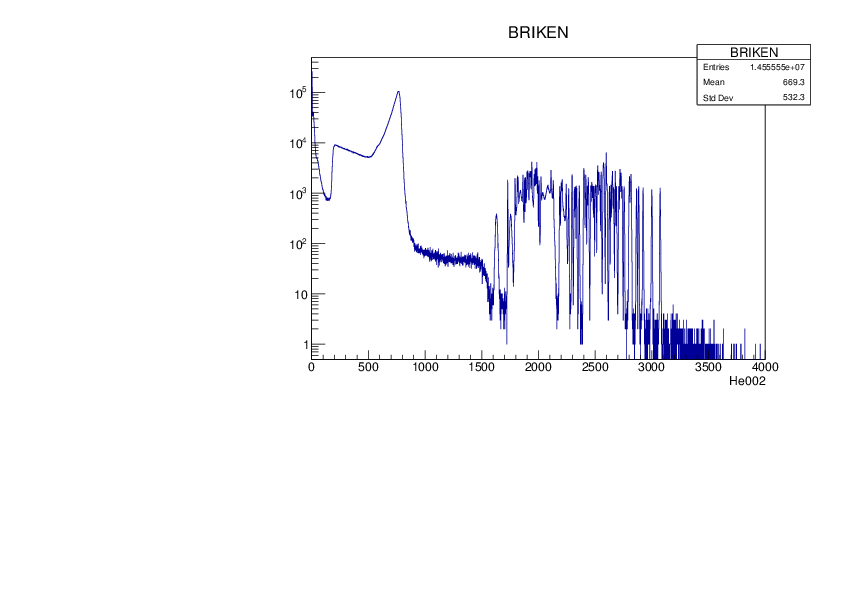
|
| Attachment 2: 161006_2235_252Cf.pdf
|

|
|
64
|
Thu Oct 6 14:43:47 2016 |
JL Tain, A Tarifeno, A Tolosa, J Agramunt, N Brewer, S Go, ... | Electronics |
We mount back all preamplifiers
Initially we used all the PA coming from US, the repaired and the new ones.
There was an issue with the new ones (strong noise and cross talk)
until we realized that the new ones were of differential type
instead of unipolar. We decided to mount all unipolar so we use
the repaired ones plus the ones which were left here and
had some minor problems with discharges.
We decided to change slightly the gain of the pulser signals
because for PA6 to PA10 the amplitude after the preamp was 2.2-2.4V
so it was saturating the ADC.
So we decreased Pulser 1 (RIKEN, ORNL1, ORNL2, CLOVER)
from 690mV to 540mV (NEG) on the scope (50ohm)
and increased Pulser 2 (UPC) from 90mV to 100mV |
|
67
|
Fri Oct 7 08:35:15 2016 |
JL Tain et al | Noise |
Low amplitude noise component.
The figure shows the composition of the low amplitude noise
which depends on the tube and type of preamplifier used.
Bkack: He020 (RIKEN-Diff)
Red: He044 (UPC-Diff)
Green: He057 (UPC-Unip)
Blue: He068 (ORNL1-Unip)
Pink: He132 (ORNL2-Unip)
(all the tubes of the same type and preamp type behave alike)
We can see up to three different structures.
The noise in the ORNL tubes extends to higher energies (200keV)
and are the cause for the overlap of noise with neutron signals,
but other wise the shape is similar to RIKEN tubes.
The noise for UPC above 50kev is quite small.
One can also see a small difference between differential and unipolar PA
in the case of UPC tubes (red and green) |
| Attachment 1: noiseDifferentTubes2.pdf
|

|
|
68
|
Fri Oct 7 10:42:52 2016 |
JL Tain et al | Noise |
We investigate the effect on the noise in ORNL tubes of using a differential PA.
We connect the tubes in current PA10 (126-140) to one of the new diff PA
and connect the output to converter card #4 which is connected to ADC3 (and ADC4).
First a short run with 252Cf for setting the right parameters and the calibration
file: 161007_1743_252Cf_ORNL_diffPreamp.root
Then we make a background run
file: 161007_1743_bck_ORNL_diffPreamp.root
As can be seen in the figure the effect of the differential preamp is to
compress the noise down to 100keV, becoming more similar to
the situation of the RIKEN tubes.
Thus it will be beneficial to use Diff PA. However as we can only setup one
because we have only one spare Diff-Unip converter card, we decided not to
use it as the impact will be very low and implies a lot of changes.
However one must remember that since we are always going to require coincidence
with betas during the measurement this noise should have no effet. |
| Attachment 1: ORNL-DiffPreamp.pdf
|

|
|
70
|
Sat Oct 8 01:18:51 2016 |
JL Tain et al | DACQ |
We increased the pretrigger delay for ADC5 from 350 to 400 |
|
71
|
Sun Oct 9 04:20:47 2016 |
JL Tain et al | Noise |
We check for the appearance of spurious signals in the preamplifiers.
We set all HV to zero and run a measurement for several hours.
Start: October 7, 20:00
Stop: October 8, 06:42
File: 161008_0642_noHV.root
De inspection of the different channels do not reveal any
particular problem.
See figure for channels grouped in rings |
| Attachment 1: noHV.pdf
|

|
| Attachment 2: 161008_0642_noHV.pdf
|
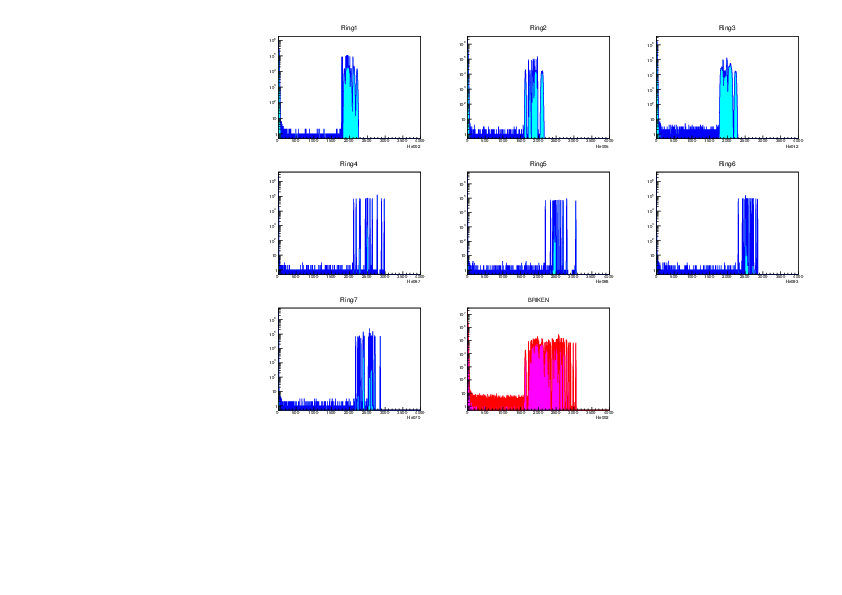
|
|
72
|
Sun Oct 9 15:49:41 2016 |
JL Tain et al | Power shutdown |
Due to maintenance operations of the Wako electrical
company there is a risk of power shutdowns on Saturday,
Sunday and Monday from about 8 am to 8 pm.
So we have to stop working on the hardware during
this time |
|
73
|
Sun Oct 9 18:19:01 2016 |
JL Tain et al | Noise |
Optimization of ADC thresholds
In order to try to reduce the grass-like background
we make a finer adjustment of individual ADC thresholds.
We make first a control measurement putting the 252Cf source
in the center of the detector (AIDA removed)
Start: -
Stop: 23:55
File: 161009_2355_252Cf_control.root
We then make an adjustment of thresholds one ADC at a time.
We adjusted the threshold so that the very low amplitude noise height
in the spectrum is only a small fraction of the pulser.
New configuration file: 160718Conf_BrikenFull_test02_thr.xlsx
A verification measurement with 252Cf
Start: 01:55
Stop: 02:09
File: 161010_0209_252Cf_newthr.root
And the leave a background measurement overnight:
Start: 02:12
Stop: 07:12
File: 161010_0712_bck_newthr.root
We compare the grass-noise rates now with the rates before threshold adjustment
For that we integrate the BRIKEN spectrum between 900keV and 1.5MeV
The rate before was 0.085 counts per second per MeV
The rate now is 0.039 counts per second per MeV
So the improvement was only a factor 2.
One can try to set the thresholds higher however with this rate the probability
of having a noise signal in a 0.5ms window after a beta signal will be about 1E-5.
The plots below show the situation before and after. |
| Attachment 1: 161007_1045_bck_lin.pdf
|

|
| Attachment 2: 161010_0712_bck_newthr.pdf
|

|
|
75
|
Tue Oct 11 15:58:01 2016 |
JL Tain et al | VETO Det |
Check of Plastic and NaI veto detectors and DACQ settings
Plastic: 10x200x450mm**3, PMT: H1161, HV: -1200V, Anode2
Very small and short signal: width: 20ns, rise: 10ns, amplitude up to 10mV
We decided to put an amplifier to have more flexibility
Amp: Ortec 474 TFA, G: 10xmax, INT=200ns, DIF: 100ns
Signal: width: 200ns, height: 100mV
DACQ Trigger & EFIR: P=2, G:2
NaI: 2"x4"x16", PMT: ?, VD: 1410 (ORNL), HV: +800V
Signal: width: 400ns height: 15mV
DACQ trigger and EFIR: P=20, G=20
File: 161011_2330_PlasticNaI_137Cs.root
File: 161011_2335_PlasticNaI_60Co.root
Photo of the arrangement.
137Cs spectrum of both detectors. |
| Attachment 1: IMG_20161012_124010.jpg
|

|
| Attachment 2: Plastic-137Cs.pdf
|

|
| Attachment 3: NaI-137Cs.pdf
|

|
|
77
|
Wed Oct 12 03:47:14 2016 |
JL Tain et al | Background |
Background measurement over night with CLOVER and VETO detectors
ADC #7 added to crate 1 for veto detectors: V1A7
VETO detectors HV off!
Start: 23:45
Stop: 10:56
File: 161012_1056_bck_noise.root
We see a very strong noise in the BRIKEN spectrum!!!
After some work we find that this was a problem
with configuration file: when editing the file
we put the calibration sheet at the beginning this
provoked a mixing of CLOVER and 3He spectra. |
|
78
|
Wed Oct 12 05:06:57 2016 |
JL Tain et al | Noise |
Gamma source close to ORNL2 tube
In order to investigate the origin of the background
component in ORNL tubes extending up to 200keV
we place a strong 137Cs source (D393) in the hole
of He136 close to the tube.
Control measurement (no source): 161012_1200_bck_control.root
With source: 161012_1229_137CsHe136.root
We observe that the induced signals are in the same energy region
as the 3rd noise component. The increase of the rate of signals
with the source is a factor 60.
See figures.
This hints to the origin of this component as due to an increased sensitivity
to gamma-rays (more material?) or internal radioactivity (gamma,beta)
of ORNL tubes. |
| Attachment 1: He136-nosource.pdf
|

|
| Attachment 2: He136-137Cs.pdf
|

|
|
80
|
Thu Oct 13 04:36:58 2016 |
JL Tain et al | CLOVER |
CLOVER energy calibration
Short run with 137Cs and 60Co sources at BRIKEN detector center
to make a new energy calibration
Root file: 161013_1240_137Cs60Co.root
We conected the test input to the pulser, and a new calibration was needed
Root file: 161013_1518_137Cs60Co.root |
| Attachment 1: 161013_1518_137Cs60Co.root
|
|
81
|
Thu Oct 13 12:58:31 2016 |
JL Tain et al | INCIDENT |
NIM Crate Failure. Lost of CLOVER G7
One of the 2 NIM crates, the one containing the power for CLOVER
preamps went kaputt.
As a consequence the preamp of CLOVER detector G7 was damaged:
G7 was removed |
|
82
|
Thu Oct 13 23:38:26 2016 |
JL Tain et al | CLOVER |
Energy and efficiency calibration
We make calibrations for the remaining D4 CLOVER detector
(No pulser: D4 preamp does not see the pulser input, a single TEST input)
Sources on the cardboard holder, place at the center of BRIKEN
137Cs (Ref:CD393) together with 60Co (Ref:CD395):
File: 161013_2331_137Cs60Co.root
152Eu (Ref:272/09-7011):
File: 161013_2350_152Eu.root
The threshold in Black,Green and Blue is cutting Ba X-rays.
Activity of the sources:
>> 60Co (Ref:CD395): 338.4 kBq (+-3%) measured on 01.07.1990
>> 137Cs (Ref:CD393): 347.9 kBq (+-3%) measured on 01.07.1990
>> 152Eu (Ref:272/09-7011): 10.62 kBq (+-1,9%) measured on 16.03.2010
See figures. |
| Attachment 1: D4All-CsCo.pdf
|

|
| Attachment 2: D4All-CsCo-zoom.pdf
|
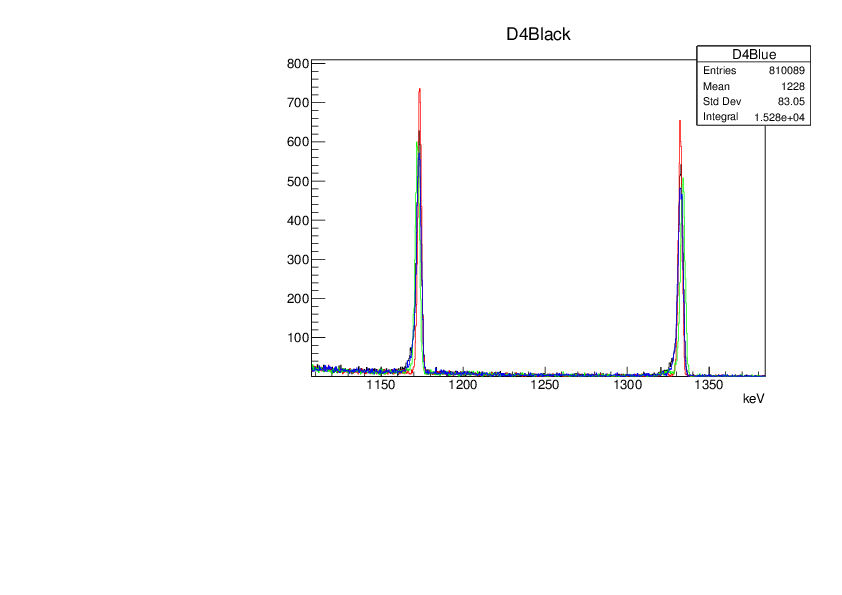
|
| Attachment 3: D4Sum-152Eu.pdf
|

|
|
83
|
Thu Oct 13 23:39:58 2016 |
JL Tain et al | VETO Det |
Energy calibration of plastic and NaI detectors
137Cs source placed in the center of the arrangement:
two plastics on top of each other the four NaI
on the sides. See photo.
First measurement:
File: 161014_0015_137Cs_VetoDetCal.root
after calibration check measurement:
File: 161014_0038_137Cs_VetoDet.root
60Co source: 161014_0047_60Co_VetoDet.root
See figures
ADC ranges at the moment:
Plast: 20 MeV
NaI: 20 MeV |
| Attachment 1: Plast-Cs.pdf
|

|
| Attachment 2: NaI-Cs.pdf
|

|
| Attachment 3: Plast-Co.pdf
|
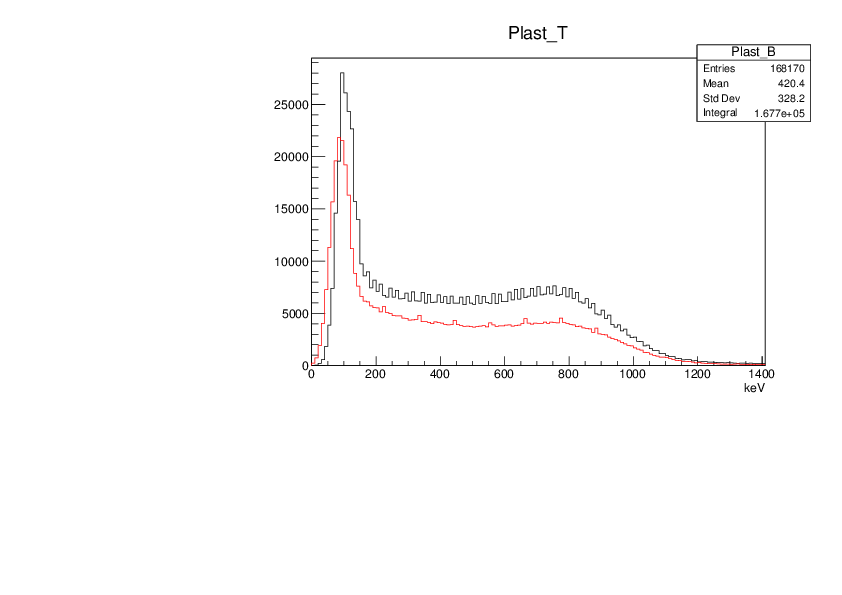
|
| Attachment 4: NaI-Co.pdf
|

|
| Attachment 5: VETO-testarrangement.jpg
|

|
|
84
|
Thu Oct 13 23:41:25 2016 |
JL Tain et al | 252Cf |
New BRIKEN energy calibration
We check the 3He tubes energy calibration with 252Cf source
We Found that only one tube He006 was slightly shifted and correct it.
Check measurement:
File: 161014_0113_252Cf.root
See figure |
| Attachment 1: 252Cf-161014.pdf
|
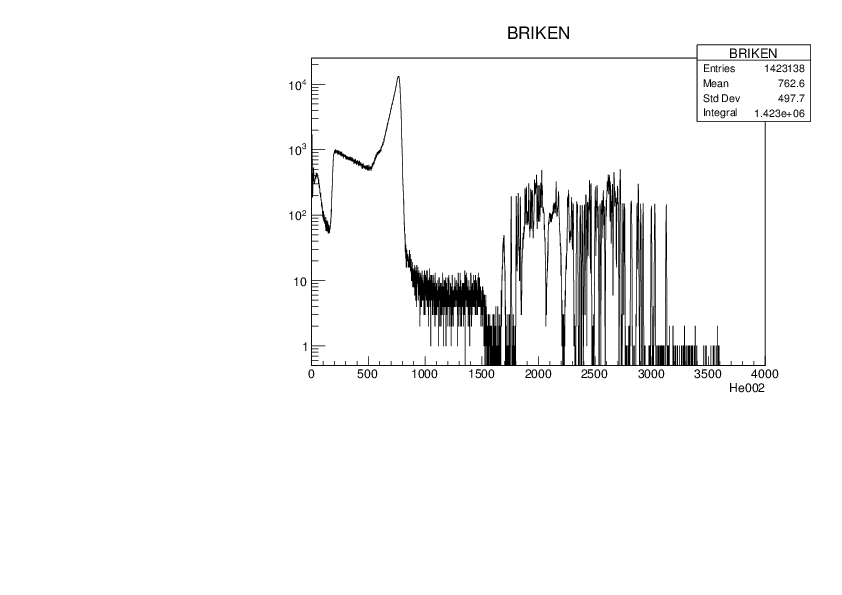
|
|
85
|
Thu Oct 13 23:42:27 2016 |
JL Tain et al | Background |
Background measurement overnight
Start: 01:17
Stop: 10:35
File: 161014_1035_bck.root
See figure |
| Attachment 1: Bckg-161014.pdf
|

|
|
86
|
Fri Oct 14 04:12:50 2016 |
JL Tain et al | CONF |
New configuration file:
161014Conf_BrikenFull.xlsx |
|
87
|
Fri Oct 14 04:42:40 2016 |
JL Tain et al | Electronics |
Change of main power line for MPOD and CLOVER preamp
Because the incident yesterday with the NIM crate,
we try to separate the CLOVER from the rest of
the equipment.
So we put the MPOD, which powers the CLOVER but also
the 3He tubes and the VETO detectors, and the preamp
power supply in a different line.
We check if this has an impact on the noise in either
CLOVER or 3He tubes.
We measure with the 137Cs-60Co source:
File: 161014_1241_137Cs60Co.root
After inspecting the spectra we conclude that the impact
is not appreciable.
See figures
662keV resolution:
D4Black: 3.16keV
D4Red: 2.49keV
D4Green: 3.57keV
D4Blue: 3.40keV |
| Attachment 1: D4All-CsCo-zoom-newlineCL.pdf
|

|
| Attachment 2: BRIKEN-newlineCL.pdf
|
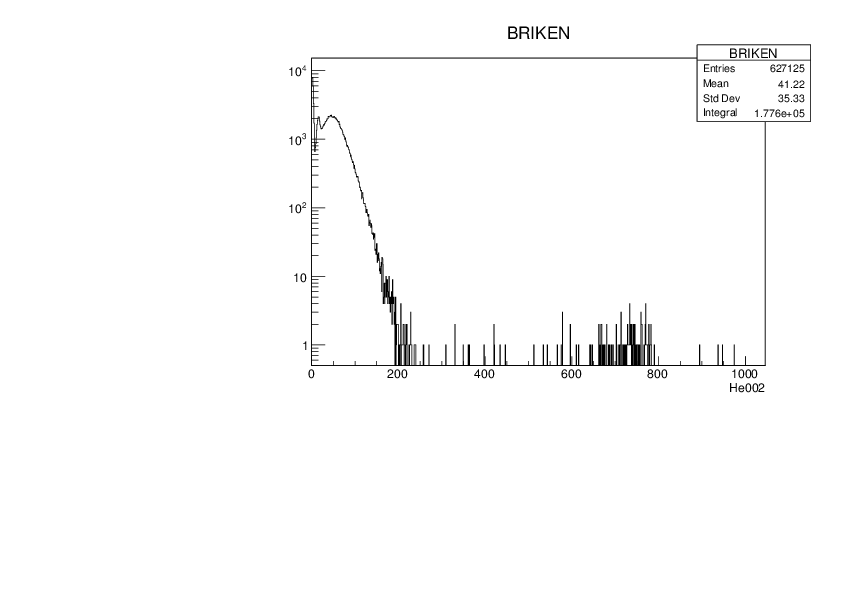
|